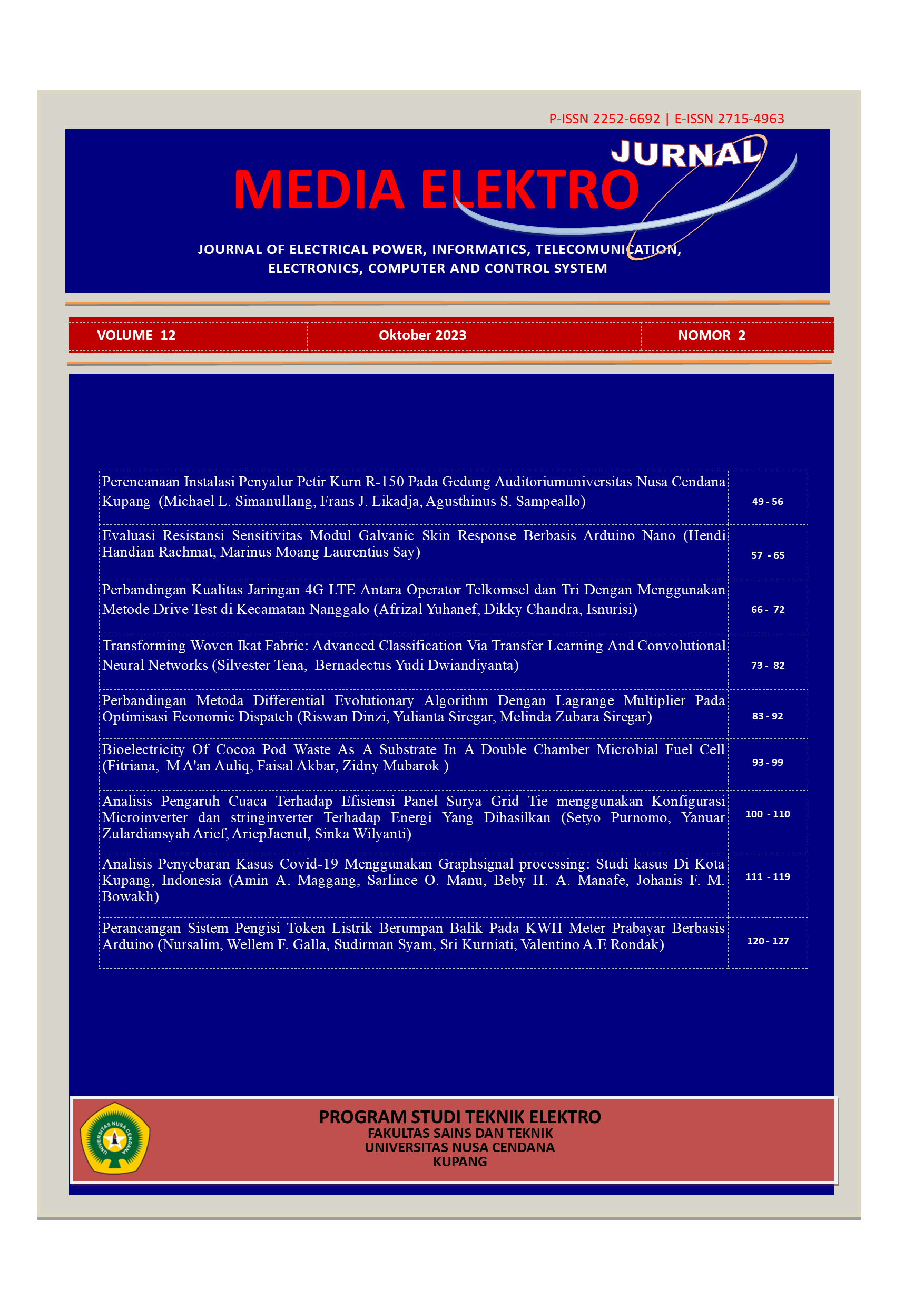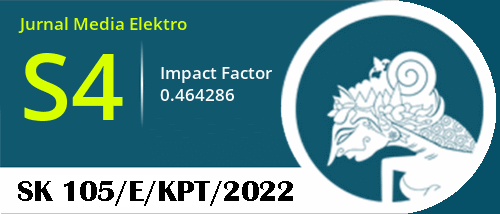BIOELECTRICITY OF COCOA POD WASTE AS A SUBSTRATE IN A DOUBLE CHAMBER MICROBIAL FUEL CELL
Abstract
Currently, the utilization of cocoa pod has not been maximized, resulting in waste and foul odors that disturb the environment. However, cocoa pod contain a relatively high amount of cellulose compounds that serve as an energy source or nutrition for bacteria to carry out metabolic activities, thus holding the potential to be used as a substrate in microbial fuel cells (MFC). Based on this, the aim of this research is to investigate the bioelectricity generated by a MFC using cocoa pod husk as a substrate, including voltage, current, and power density, in order to determine the potential of cocoa pod husk waste as an electrical energy source. In this study, a double chamber MFC consists of an anode chamber with copper electrodes and a cathode chamber with zinc electrodes, separated by a salt bridge. The bacteria used were Saccharomyces cerevisiae, and the substrate was made from cocoa pod husk waste. Bioelectricity testing involved measuring the voltage, current, and power density produced by the MFC over several minutes. The measurement results for maximum voltage, maximum current generated, and maximum electrical power (at 6 days) from the reactor were as follows: 36.0 mV, 0.19 mA, and 456 mW/m2, respectively.
Downloads
References
A. E. Setyono Dan B. F. T. Kiono, "Dari Energi Fosil Menuju Energi Terbarukan: Potret Kondisi Minyak Dan Gas Bumi Indonesia Tahun 2020 - 2050," J. Energi Baru Dan Terbarukan, Vol. 2, No. 3, Hal. 154-162, 2021, Doi: 10.14710/Jebt.2021.11157.
https://doi.org/10.14710/jebt.2021.11157
B. A. Nugraha Dan T. P. Sopandi, "Pengolahan Limbah Kulit Jeruk Sebagai Sumber Energi Terbarukan Di Desa Selorejo, Kabupaten Malang: Literature Review," Jukung (Jurnal Tek. Lingkungan), Vol. 8, No. 1, Hal. 1-17, 2022, Doi: 10.20527/Jukung.V8i1.12965.
https://doi.org/10.20527/jukung.v8i1.12965
L. Utami, Lazulva, Dan Y. Fatisa, "Electricity Production From Peat Water Uses Microbial Fuel Cells Technology," Indones. J. Chem. Sci. Technol. State, Vol. 2, No. 1, Hal. 55-60, 2019.
https://doi.org/10.24114/ijcst.v2i1.12371
A. T. Hoang Et Al., "Microbial Fuel Cells For Bioelectricity Production From Waste As Sustainable Prospect Of Future Energy Sector," Chemosphere, Vol. 287, No. 3, 2022.
https://doi.org/10.1016/j.chemosphere.2021.132285
PMid:34563769
M. Hariti, R. Chemlal, M. Drouiche, Dan N. Mameri, "The Influence Of Organic Pollutant Load And External Resistance On The Performance Of A Solid Phase Microbial Fuel Cell Fed Orange Peel Wastes," Environ. Prog. Sustain. Energy, Vol. 40, No. 5, Hal. 1-8, 2021, Doi: 10.1002/Ep.13667.
https://doi.org/10.1002/ep.13667
S. Rojas-Flores Et Al., "Bioelectricity Through Microbial Fuel Cells Using Avocado Waste," Energy Reports, Vol. 8, Hal. 376-382, 2022, Doi: 10.1016/J.Egyr.2022.06.100.
https://doi.org/10.1016/j.egyr.2022.06.100
L. Utami, Lazulva, Dan Y. Fatisa, "Produksi Energi Listrik Dari Limbah Kulit Pisang (Musa Paradisiaca L.) Menggunakan Teknologi Microbial Fuel Cells Dengan Permanganat Sebagai KatoliT," vol. 5, no. 2, hal. 62-67, 2018.
https://doi.org/10.15575/ak.v5i2.3833
S. Rojas-Flores et al., "Potential use of papaya waste as a fuel for bioelectricity generation," Processes, vol. 9, hal. 1-11, 2021, doi: 10.3390/pr9101799.
https://doi.org/10.3390/pr9101799
R. Segundo et al., "Increase in Electrical Parameters Using Sucrose in Tomato Waste," Fermentation, vol. 8, hal. 1-10, 2022.
https://doi.org/10.3390/fermentation8070335
R. Arigeni, M. R. Kirom, dan A. Qurthobi, "Analisis Produksi Energi Listrik Pada Microbial Fuel Cell Menggunakan Substrat Tongkol Jagung Dengan Kontrol Suhu," e-Proceeding Eng., vol. 6, no. 1, hal. 1091-1096, 2019.
H. Purnamawati, B. Utami, P. Kimia, F. Keguruan, U. S. Maret, dan J. I. S. A, "Pemanfaatan Limbah Kulit Buah Kakao ( Theobroma cocoa L .) Sebagai Adsorben Zat Warna Rhodamin B," in Prosiding Seminar Nasional Fisika dan Pendidikan Fisika (SNFPF) Ke-5 2014, 2014, vol. 5, hal. 12-18.
R. Compos-Vega, K. H. Nieto-Figueroa, dan B. D. Oomah, "Cocoa (Theobroma cacao L.) Pod Husk: Renewable Source Of Bioactive Compounds.," Trends Food Sci. Technol., vol. 81, hal. 172-184, 2018.
https://doi.org/10.1016/j.tifs.2018.09.022
L. Utami, Lazulva, dan E. Yenti, "Produksi Energi Listrik Dari Limbah Kulit Pepaya (Carica papaya) Menggunakan Teknologi Microbial Fuel Cells," Al-Kimia, vol. 6, no. 1, hal. 2018, 2018.
R. R. Yogaswara, A. S. Farha, M. Dian, dan A. Gunawan, "Studi Penambahan Mikroorganisme Pada Substrat Limbah Pome Terhadap Kinerja Microbial Fuel Cell," J. Tek. Kim., vol. 12, no. 1, hal. 14-18, 2017.
https://doi.org/10.33005/tekkim.v12i1.839
D. Permana et al., "Preliminary Investigation of Electricity Production Using Dual Chamber Microbial Fuel Cell ( DCMFC ) with Saccharomyces cerevisiae as Biocatalyst and Methylene Blue as an Electron Mediator," Procedia Chem., vol. 17, hal. 36-43, 2015, doi: 10.1016/j.proche.2015.12.123.
https://doi.org/10.1016/j.proche.2015.12.123
M. Latif, A. D. Fajri, dan M. Muharam, "Penerapan Sampah Buah Tropis untuk Microbial Fuel Cell," J. Rekayasa Elektr., vol. 16, no. 1, hal. 1-7, 2020, doi: 10.17529/jre.v16i1.15723.
This work is licensed under CC BY-SA 4.0

 Fitriana Fitriana(1*)
Fitriana Fitriana(1*)












